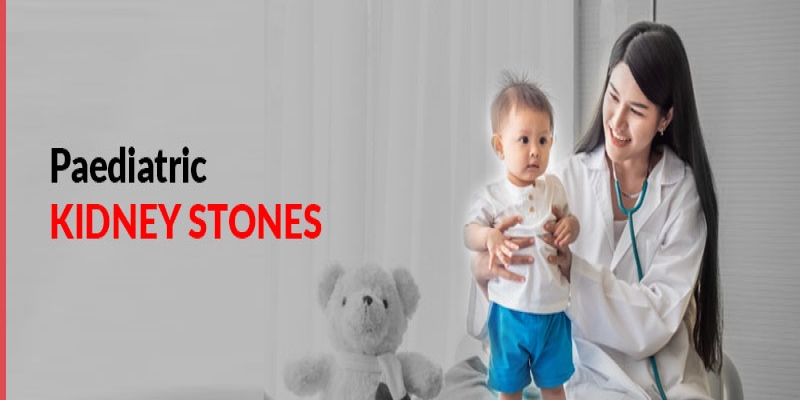Kidney Stone Management in Infants (Paediatric Stone Management)
2019-10-04 / RG STONE HOSPITAL / Urinary / Kidney Stone

Kidney stones occur when the urine becomes over-saturated with waste chemicals leading to the formation of small crystals in the urine. These crystals grow into stones and get larger with time.
Children, especially infants (0-2 years of age), constitute a very small number of total patients with urinary stones. However, stone disease in pediatrics is an important problem due to its high recurrence rate. In recent times, the incidence of pediatric stone disease has increased due to hypercalciuria (elevated calcium in urine) and hypocitraturia (low amount of citrate in urine).
Kidney stones can commonly occur in children living in hot climates or if they have any birth defects in their urinary tract. Family history is also a risk factor. Some studies have shown that kids with a history of consuming milk powder adulterated with melamine are at high risk of developing kidney stones.
The symptoms in children with stone disease may range from pain in the belly or back, flank pain and blood in urine (hematuria) to non-specific symptoms such as irritability, nausea/vomiting, and rushing to bathroom. Some children may remain symptomless. The stone blocks the urinary tract & prevents the normal flow of urine. If the blockage is not treated quickly, it can cause permanent damage to the kidney(s) (can even lead to kidney failure).
Diagnostic procedures include ultrasonography and radiography.
The treatment procedure depends upon the size, location and nature of the stone and the biochemical abnormalities in the body. Urine volume increases with body mass index.
Extracorporeal shock wave lithotripsy (ESWL) is the treatment of choice for kidney stone in many pediatric cases. This procedure uses high-energy shock wave to break the stone into fragments that are then passed in urine. The procedure takes about 20 minutes.
The upper urinary tract stones that cannot be treated with ESWL are cleared with a minimally invasive surgical procedure called percutaneous nephrolithotripsy’ (PCNL). In this procedure, small instruments are passed through the skin (percutaneously) into the kidney to remove the stone with laser.
The improved ureteroscopic access to stones through the urinary tract is more advisable owing to its non-invasive high stone-free rates. Ureteroscopy is a procedure that can be done if the stone is in the middle or lower portion of the ureter. A doctor passes a small instrument (ureteroscope) through the urethra and bladder, into the ureter. The stone can be removed or broken up into smaller pieces that can pass easily in urine. The children have elastic ureters which allow the stones to pass more easily.
Children with kidney stones have a significant chance of stone recurrence; in around 30-60%. cases However, few precautions can decrease the chances of developing another stone.
Limiting salt & calcium in diet and drinking plenty of water are the best tools to prevent the most common types of kidney stones or to slow their growth, but the practicality of application of these dietary guidelines in children is unknown. Infants must be given 750 ml or more (25 ounces or 3 cups) fluids everyday. Children below 5 years of age should be given 1000 ml or more (33 ounces or 4 cups) fluids. Children between 5-10 years of age — 1500 ml or more (50 ounces or 6 cups) and children over 10 years of age — 2000 mL or more (66 ounces or 8 cups).
Children who have high levels of oxalate in the urine should avoid vitamin C supplements and avoid foods that contain large amounts of oxalate, including beet (chakundar) and turnip greens (shalgam), strawberries, sweet potatoes, wheat bran, tea, cocoa, pepper, chocolate, parsley (ajmoda), spinach (paalak), nuts, and citrus juices.
RG Stone hospital has been the first Institute to treat the youngest patient with stone (6 months).
Know more about - kidney stone Symptoms, Causes & Treatment
Categories
Hernia Repair
Appendicitis
Piles
Urological Treatment
Hernia treatment
Enlarged Prostate (BPH)
Gall Bladder Stone
Urinary / Kidney Stone
Vitamins
Indian Health Care System
Exercise
Obesity
Female Urinary Incontinence
Single Incision Laparoscopic Surgery (SILS)
Kidney Cancer
Bladder Cancer
Ovarian cancer
Nephrology
Bariatric Surgery
Kidney Function Test
Female Urology
Radiation Therapy
Alcoholic Fatty Liver
Liver disease
Gastroenterology
Kidney Disease

